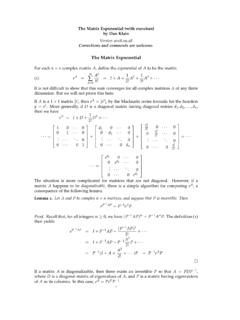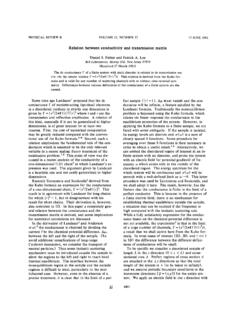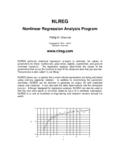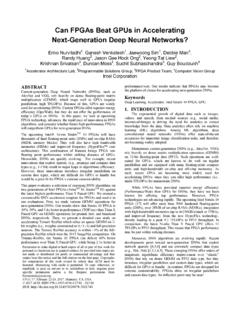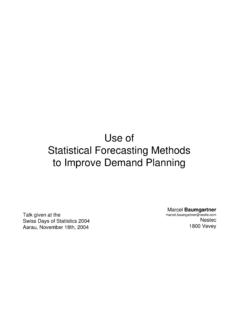Transcription of Solution of Differential Equations using …
1 IOSR Journal of Mathematics (IOSR-JM) e-ISSN: 2278-5728. Volume 5, Issue 3 (Jan. - Feb. 2013), PP 12-17 12 | Page Solution of Differential Equations using exponential of a matrix Jervin Zen Lobo 1, Terence Johnson 2 1(Basic Sciences & Humanities Department, Agnel Institute of Technology and Design, Goa University, India) 2(Computer Engineering Department, Agnel Institute of Technology and Design, Goa University, India) Abstract : Our main purpose in this project is to help reader find a clear and glaring relationship between linear algebra and Differential Equations , such that the applications of the former may solve the system of the latter using exponential of a matrix .
2 Applications to linear Differential Equations on account of eigen values and eigenvectors, diagonalization of n-square matrix using computation of an exponential of a matrix using results and ideas from elementary studies form the core study of our project. Keywords : matrix ,fundamental matrix , ordinary Differential Equations , systems of ordinary Differential Equations , eigenvalues and eigenvectors of a matrix , diagonalisation of a matrix , nilpotent matrix , exponential of a matrix I. Introduction The study of Ordinary Differential Equation plays an important role in our life. Some applications include study of growth of microorganisms, population, decay of radiation, etc.
3 Ordinary Differential Equations is also used in medicine. Solving a first order Ordinary Differential Equation of first degree could be elementary as we have many ways of doing so the Ordinary Differential Equation could be linear, homogenous; or we could solve it finding suitable integrating factor to make it exact, etc. In solving a second order non-homogenous Differential equation, we have many methods namely: method of undetermined coefficient also called method of judicial guessing, method of variation of parameters, Inverse D-opertor method, etc. The homogenous part can well easily be solved by finding the roots of the auxiliary equation.
4 However, as the order of the Ordinary Differential Equation goes higher, it becomes more tedious to solve the homogenous/non-homogenous part. In such cases, we reduce the nth order Ordinary Differential Equation into a system of n first order Linear Differential Equation. II. Main Idea Of The Proposed Solution In this paper we propose to solve a system of first order linear Differential Equations using techniques of linear algebra. The innovative part of our paper is the use of exponential of a matrix to find the required Solution of the system. We know for any matrix A.
5 !3!232 AAAIeA If A is nilpotent of degree n, the infinite sum above terminates at some point. In our paper, we use exponential of matrix in following manner: Step 1 Write the given system in matrix form. Call the state transition matrix as A. Step 2 Find eigenvalues and eigenvectors of A. Form the matrix P whose columns are eigenvectors of A. Step 3 Compute P-1AP which will be diagonal. For example P-1AP = diag( 1 1 ). Step 4 Write A = P diag ( 1 1 ) p-1. Hence tA = Pdiag(t 1t 1t ) p-1. Finally etA = Pdiag (et ,et et ) p-1 Step 5 using result that general Solution of x1 = Ax is x(t) = etA C.
6 The Solution is etA. C; etA being obtained from step 4 III. Solution of Differential Equations using exponential of a matrix Theorem: A matrix Solution (t) of =A (t) is a fundamental matrix of x =A (t) x iff w (t) 0 for t (r1,r2). Proof: Let (t) be a fundamental matrix of x = A (t) x with column vectors 1, n. Solution of Differential Equations using exponential of a matrix 13 | Page Let (t) be a Solution of x =A(t) x. then njjjtct1)()( for some constants c1,c2,.. cn not all zero. By uniqueness of a Solution cj s are all unique.
7 If c=(c1,c2,..cn) then (t)= (t)c For any t0 (r1,r2) above relation represents n-linear algebraic Equations in the n-unknowns c1,c2,..cn and has unique Solution . Det (t) 0 W(t) 0 r1 < t <r2 Let W(t) 0 t (r1,r2) 1, n are linearly independent. (t) is a fundamental matrix . Theorem: The general Solution of x =Ax is x(t) = etA c where c is an arbitrary constant vector. The Solution of x =Ax with initial condition x(t0)=x0 is given by x(t) = e(t-t0)A x0. Proof: Let x(t) be any Solution of x =Ax Define u(t) =e(-tA) x(t) = 0 u (t) = e-tA x (t)- A e(-tA) x(t) = 0 u (t) = c.
8 X(t) = etA c. Now, x(t0) = et0A c x0 = et0A c c = e-t0A x0 x(t) = etA e-t0A x0 = e(t--t0)A x0 (t)= etA is the fundamental matrix of x = Ax, as (t) = )(tAedtd = AetA = A (t) Variation of Constant Formula: Any Solution of x (t) = A(t)x(t) + B(t) such that x(t0) = x0 is given by, x(t) = dssBsxt)()()(10 where )(t is a fundamental matrix of x (t) = A(t)x(t) such that )(0t = I. Proof: Let x(t) = )(t C(t), where C(t) is an unknown vector on ),(21rr. x(t0) = )(0t C(t0) 00)(xtC . Solution of Differential Equations using exponential of a matrix 14 | Page )()()()()()(tCttAtCttx )()()()()()()()(.
9 TCttAtCttBtxtAei )()()()(txtAtCt ).()()(..tCttBei ).()()(1tBttC ttttdssBsdssC00)()()(1 ttdssBstCtCei0.)()()()(..10 ttdssBsxtC0)()()(10 .)()()()()(100dssBstxttxtt IV. Experimental Results Solve the following system of linear first order : zyxdtdzzyxdtdyzyxdtdx 2234 Soln: The given system can be put in the form. 112123411,'AwhereAXX The characteristic polynomial of matrix A is 112123411)(IAP = (1- )( -3)( +2) The eigenvalues of A are 1=1, 2=3 and 3=-2 Put 1 = 1 in (A- 1)
10 V=0 we get, 000212113410321vvv Solution of Differential Equations using exponential of a matrix 15 | Page R1 R3 000410113212321vvv R1 R1/2 00041011312/11321vvv R2 R2-3R1 00041022/1012/11321vvv R2 R2-3R1 00041011312/11321vvv R2 R2-3R1 221,21100041022/1012/113321321 RRRRRRvvv 000000410101321vvv v1+v3 = 0 and v2-4v3=0 Choose v3 = 1 v1 = -1, v2=4. 1411V is an eigen vector of A corresponding to the eigen value 1=1 Similarly, 1212 Vis an eigen vector of A corresponding to the eigen value 2 = 3 and 1113 Vis an eigen vector of A corresponding to the eigen value 3 = -2.










